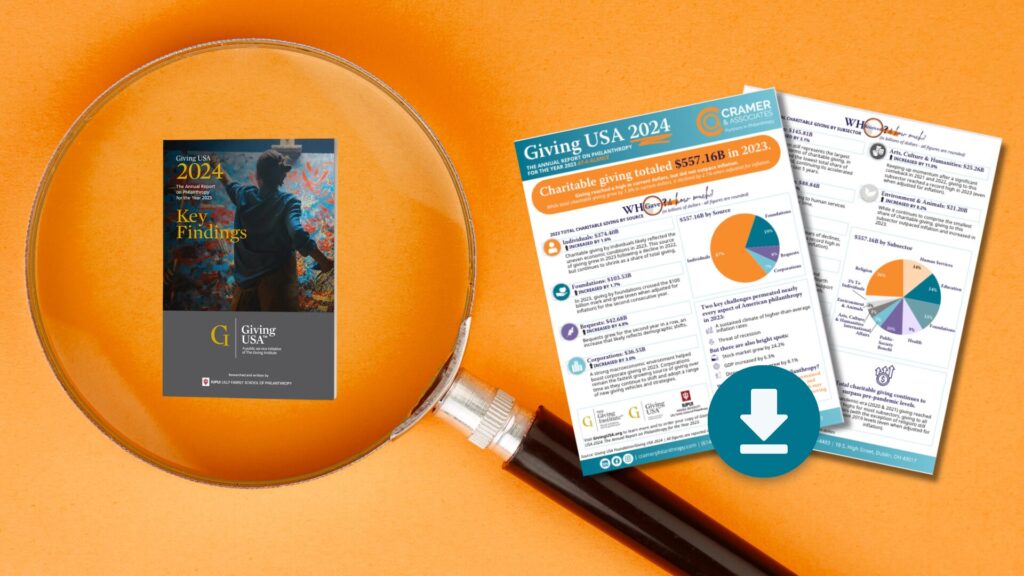By: Dawn Robinson, CFRE & Mike Schmidt, CFRE
The ever-changing nature of recent years has sparked reflection in so many aspects of our daily lives – priorities have shifted and many development professionals have re-evaluated how their time and resources are spent. The same is true for donors. Gone are the days of back-to-back, over-the-top, crowded fundraising luncheons and galas that individual donors and corporations filled their schedules with before the pandemic. We are now seeing a seismic shift towards smaller gatherings and mission-focus making event-based fundraising successful. This may have been sparked by social distancing and global health concerns, but we think the shift is here to stay regardless of the state of the pandemic, and for good reason. Covid may have been the catalyst, but we’ve heard funders saying for years how they want their efforts to be much more mission-driven for impact rather than for show.
Whatever decision you make to move forward with your nonprofit’s event-based fundraising strategies, there are key suggestions to keep in mind for events of any type or size that can make or break their engagement levels and overall success.
The Virtual Fundraising Event

While Zoom and other methods of virtual communication have been a major blessing to all of us in a time when real-life interactions were not safe or possible, these methods are not always well-suited for replacing beneficial face-to-face time when it comes to events. Virtual gatherings that felt novel in the early months of the pandemic lost longevity because too often the level of engagement and authenticity was lost in screen shares, mute buttons and multi-tasking tendencies of attendees.
Let’s be honest, who hasn’t “attended” a virtual event while also cooking dinner or doing laundry? It is simply not as easy to engage donors and other supporters in your nonprofit’s mission, vision and goals when undivided attention and connection fall to the wayside. If you are planning on a virtual event as part of your event-based fundraising strategy, consider the following:
Tips:
- Use reliable technology. If you are staying with this platform, make the investments to ensure smooth communication.
- Consider innovative ways to keep attendees involved. Whether it’s through an interactive Q&A session with program staff or leaders, or an interactive mixology component that breaks up the event, keeping people actively engaged is the key to success for any virtual gathering because it holds attention and helps deter distractions away from your message.
- Keep it short. The potential for external distractions is high when attendees are remote, so brief and succinct agendas are critical.
- Consider the medium. Many early users of virtual tools were broadcast to larger monitors and screens but many of today’s viewers are utilizing their phones. This requires less use of small text or wide view shots.
The Big Fundraising Event

In recent years we have seen the trend of donors and corporations moving toward trust-based philanthropy models that focus on casting their charitable resources deeper with select nonprofits that closely align with their values. This is allowing nonprofits to direct the funding straight to operations and programming, providing funders with a greater mission return on their investment. This is also having an impact on funders’ willingness to spread themselves thin by attending and sponsoring fundraising events from a wider array of nonprofits whose missions do not necessarily demonstrate a match to their mission funding goals.
Traditionally, the goal of these big fundraising galas has simply been to ‘raise awareness’ of the organization – but to whom? Unless you are able to effectively immerse your attendees in your mission through the event, the likelihood of converting any attendees into long-term donors or volunteers of your organization is low. Many of today’s donors would prefer to put the funds that would have been put toward buying a table at a costly banquet style “chicken dinner” directly toward the organization to make an even meaningful impact.
If your nonprofit has successfully hosted a big fundraising event for years that is well attended, proven effective, and has a strong ROI, don’t simply toss it in the trash in light of the evolving fundraising landscape. Instead, consider innovating or tweaking the format of the event with more mission moments or interactive activities.
Tips:
- All bigger style galas/luncheons have an arc and should be reevaluated for their effectiveness every 2-3 years.
- Create an experience for your guests that puts the direct impact of your mission at the forefront of your event’s agenda.
- Tie the allocation of the charitable dollars raised from the event to a very specific initiative, and make sure to clearly communicate this so that donors can easily quantify the direct impact they are having on your mission via the event!
- Take time to look at your true return on investment (ROI) from the event to determine if it still makes sense. Don’t just look at the amount of dollars raised; consider the true expenses and resources it took to put on the event. How much did the venue and catering cost? How many hours did your staff put into planning and executing the event? What was the cost for A/V and event giveaways at the tables?
- If the goal is truly awareness or stewardship, consider finding underwriters for the overall event and convert it into an immersive mission experience with little or no cost to attend. This can lead to greater overall relationship building with existing and potential donors.
(TREND) The Small, Intimate Fundraising Gathering:

The goals of hosting smaller, more intimate event-based fundraising is simple! Aside from the obvious goal of raising funds, it is to cultivate deeper relationships with potential or existing donors. As we like to say at Cramer, clear is kind; and in today’s world, these smaller, intimate events are where we see fundraising thrive because authentic human connection is at their core. Also, follow-up and continued engagement after the event is more manageable with a smaller group. A small event offers an opportunity for attendees to experience a connection to the mission and socializing that they are craving after what may have been an isolating period of time for many. This type of event-based fundraising tends to be less overwhelming and allows for more two-way conversation about the organization’s mission and impact.
Tips:
- Identify a host (or two) who is passionate and involved with your organization, and have the invite go out on behalf of them vs. the organization.
- Have the hosts talk about their personal connection to the nonprofit at the event. A firsthand, heartfelt account of the organization’s impact will always go further than your CEO reading an objective report filled with numbers.
- If at all possible, consider hosting this type of smaller event at your organization. Donors are craving the opportunity to see your mission in motion.
- If your location is not possible, consider an in-home event or unique venue that would allow for personal testimony from a program success story or an activity that demonstrates mission impact.






